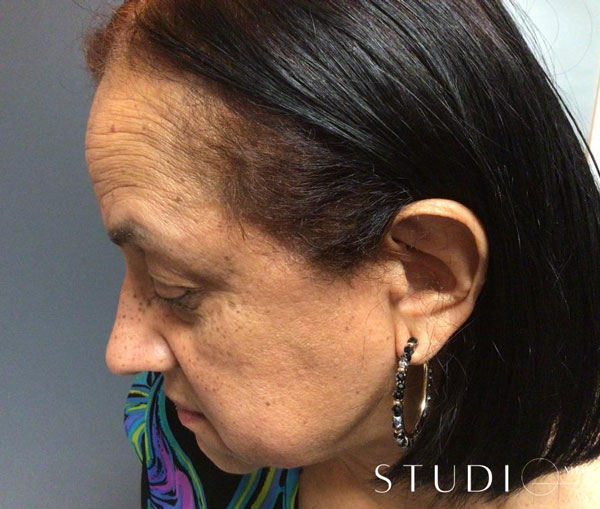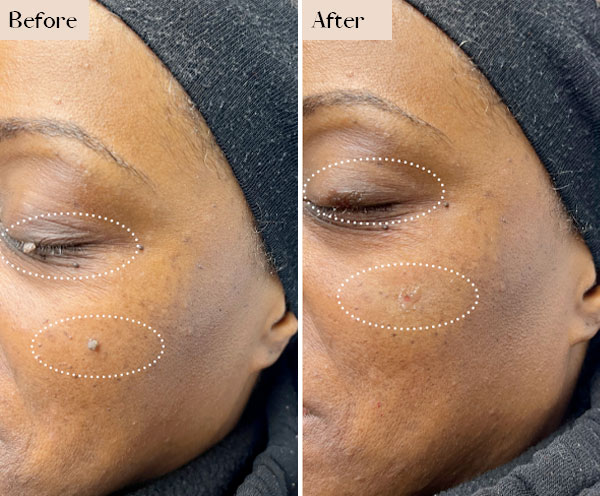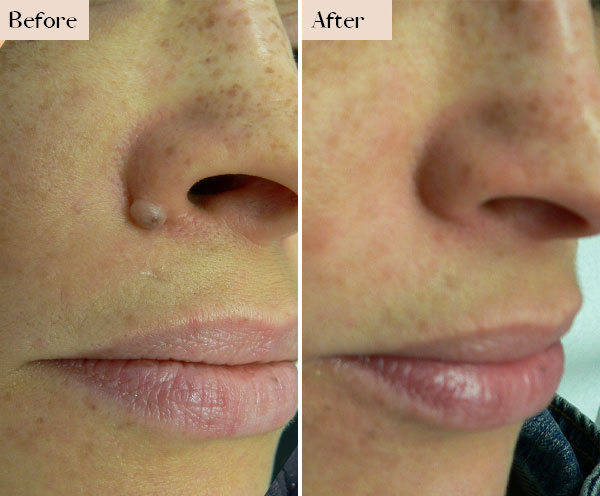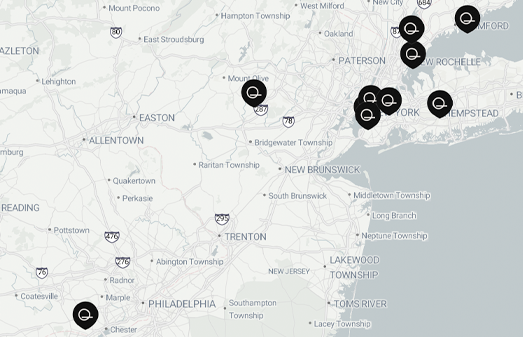Mole, Skin tag, Wart Removal
GOAL
To remove skin lesions, (moles, warts, skin tags and more) without scarring
TECHNOLOGY
Radiowave device or laser
DOWNTIME
Minimal to Moderate
COST
One mole/wart: starts at $450, and $400 for each additional.
For more, ask doctor during consultation for customized pricing.
Skin tags: starts at $450, $200 for each additional.
For more, ask doctor during consultation for customized pricing.
Skin tags: starts at $450, $200 for each additional.


Real people. Real results.



READY TO BOOK A FREE CONSULTATION?
Easy Peasy!
Submit Form Below or Click to Book Online or Call (718) 313-0094
FREQUENTLY ASKED QUESTIONS
WHAT IS RADIOSURGERY?
Radiowave is a technology used to treat a variety of soft tissue conditions, from the skin to deeper tissues. The treatment of warts, moles, and other skin growth takes only a few minutes with this technology.
WHAT AREAS ARE MOST SUITABLE TO PERFORM RADIOSURGERY?
Radiosurgery effectively removes outgrowths present on any part of your body:
Face: The technique is particularly useful for facial growths and acne spots as there is no scarring and the healing period is short.
Armpits / Breasts / Neck / Groin: The technique is often used to remove skin tags under the armpits or breasts, around the V-line of neck, and in the groin.
Arms / Legs / Back: It removes brown spots, solar keratoses, and other growths.
Face: The technique is particularly useful for facial growths and acne spots as there is no scarring and the healing period is short.
Armpits / Breasts / Neck / Groin: The technique is often used to remove skin tags under the armpits or breasts, around the V-line of neck, and in the groin.
Arms / Legs / Back: It removes brown spots, solar keratoses, and other growths.
WHAT IS THE COST OF MOLE REMOVAL WITH RADIOSURGERY TREATMENT IN BROOKLY?
$250 for one mole. $200 per mole if more than one mole.
WHAT ARE THE ADVANTAGES OF THIS PROCEDURE?
There are various benefits to this procedure, including:
• Removing protruding moles that get in the way of shaving.
• Reducing skin irritation that can occur when certain moles rub against clothing or jewelry.
• Achieving smoother, clearer skin.
• Enhancing appearance and improving self-esteem.
Most importantly, if a mole is suspected to be pre-cancerous early on, it can often be completely removed before it causes a serious health risk.
• Removing protruding moles that get in the way of shaving.
• Reducing skin irritation that can occur when certain moles rub against clothing or jewelry.
• Achieving smoother, clearer skin.
• Enhancing appearance and improving self-esteem.
Most importantly, if a mole is suspected to be pre-cancerous early on, it can often be completely removed before it causes a serious health risk.
WHO WOULD BEST REPRESENT AN IDEAL CANDIDATE FOR MOLE REMOVAL?
Those people who can physically and emotionally benefit from having their mole removed would be considered a good candidate for the procedure. However, people must remember that there are limitations to what cosmetic surgery can do. It is meant for improvement, not perfection and is important to have realistic goals and expectations about mole removal.
HOW IS THE MOLE REMOVAL PROCEDURE?
The lesion/mole is first prepped with isopropyl alcohol, injected with a small amount of lidocaine 2% (anesthetic), and then painlessly removed using a radio-surgery electrode*. During the procedure, the treated area is cauterized as the lesion is being removed. This means that the treated area is free of bleeding and therefore ready to be prepped with a triple antibiotic ointment and a band-aid immediately afterwards.
After the procedure, patients are asked to keep the treated area clean and free of contaminents until the wound has scabbed over. This post-procedure maintenance is done by simply cleaning the wound with mild soap and water, applying the triple antibiotic ointment (supplied by us), and a band-aid 1-2 times a day for 2 to 4 days. Typically patients see new skin after a week which is usually pink in color. The new skin then gradually starts to match the surrounding skin in days to weeks.
After the procedure, patients are asked to keep the treated area clean and free of contaminents until the wound has scabbed over. This post-procedure maintenance is done by simply cleaning the wound with mild soap and water, applying the triple antibiotic ointment (supplied by us), and a band-aid 1-2 times a day for 2 to 4 days. Typically patients see new skin after a week which is usually pink in color. The new skin then gradually starts to match the surrounding skin in days to weeks.
WHAT ARE SKIN TAGS AND HOW TO REMOVE THEM WITH RADIOSURGERY?
If you're wondering what a skin tag is, then you probably don't have them. Those who are affected by skin tags, especially large numbers of them, are often a bit self-conscious about wearing skin-bearing clothes. Skin tags are those tiny pearl or seed-like moles that appear to hang off of the skin and look as though they could be easily removed but in fact, are quite firmly attached to the skin's surface. Whereas a mole is connected to the skin by its entire surface, a skin tag is attached only superficially by a tiny point at its base. As we get older, we may notice a growing abundance of skin tags, particularly on the face, neck, chest and arms.
Skin Tags, also known as cutaneous skin tags, fibroepithelial polyps or acrochordons, are usually benign (non-cancerous) skin growths. These growths that are usually small are very common in people older than 30 and are thought to occur from skin rubbing against skin or clothes and shaving. These tags are generally located on the neck, armpits, trunk, body folds, and other areas. They are generally flesh colored (occasionally darker). They stick out of the skin and may have a short narrow stalk connecting to the skin surface. They are usually harmless and painless however they may be irritated from rubbing on clothing or other materials.
Skin Tags, also known as cutaneous skin tags, fibroepithelial polyps or acrochordons, are usually benign (non-cancerous) skin growths. These growths that are usually small are very common in people older than 30 and are thought to occur from skin rubbing against skin or clothes and shaving. These tags are generally located on the neck, armpits, trunk, body folds, and other areas. They are generally flesh colored (occasionally darker). They stick out of the skin and may have a short narrow stalk connecting to the skin surface. They are usually harmless and painless however they may be irritated from rubbing on clothing or other materials.
HOW IS THE SKIN TAG PROCEDURE?
The lesion/skin tag is first prepped with isopropyl alcohol, injected with a small amount of lidocaine 2% (anesthetic), and then painlessly removed using a radio-surgery electrode*. During the procedure, the treated area is cauterized as the lesion is being removed. This means that the treated area is free of bleeding and therefore ready to be prepped with a triple antibiotic ointment and a band-aidimmediately afterwards.
After the procedure, patients are asked to keep the treated area clean and free of contaminents until the wound has scabbed over. This post-procedure maintenance is done by simply cleaning the wound with mild soap and water, applying the triple antibiotic ointment (supplied by us), and a band-aid 1-2 times a day for 2 to 4 days. Typically patients see new skin after a week which is usually pink in color. The new skin then gradually starts to match the surrounding skin in days to weeks.
After the procedure, patients are asked to keep the treated area clean and free of contaminents until the wound has scabbed over. This post-procedure maintenance is done by simply cleaning the wound with mild soap and water, applying the triple antibiotic ointment (supplied by us), and a band-aid 1-2 times a day for 2 to 4 days. Typically patients see new skin after a week which is usually pink in color. The new skin then gradually starts to match the surrounding skin in days to weeks.
WHAT CAUSES WARTS IN SKIN AND HOW TO REMOVE THEM WITH RADIOSURGERY?
Warts are caused by HPV (Human Papilloma Virus), which is a DNA virus. More than 100 different types of HPV have been identified. These include Common Warts, Palmar or Plantar Warts, Flat Warts, Cystic Warts, Genital Warts and many other types. HPV is spread by direct or indirect contact. Autoinoculation may also occur, causing local spread of lesions.
Multiple modalities are available for the treatment of warts, but most are not uniformly effective.
These include topical agents such as salicylic acid, canthardin, trichloroacetic acid, podophyllin and more. Some physicians have used cryotherapy (freezing with liquid nitrogen), lasers or prescription systemic and topical medications, which have also shown minimal effectiveness.
These include topical agents such as salicylic acid, canthardin, trichloroacetic acid, podophyllin and more. Some physicians have used cryotherapy (freezing with liquid nitrogen), lasers or prescription systemic and topical medications, which have also shown minimal effectiveness.
HOW IS THE WART REMOVAL PROCEDURE?
The lesion/wart is first prepped with isopropyl alcohol, injected with a small amount of lidocaine 2% (anesthetic), and then painlessly removed using a radio-surgery electrode*. During the procedure, the treated area is cauterized as the lesion is being removed. This means that the treated area is free of bleeding and therefore ready to be prepped with a triple antibiotic ointment and a band-aid immediately afterwards.
After the procedure, patients are asked to keep the treated area clean and free of contaminants until the wound has scabbed over. This post-procedure maintenance is done by simply cleaning the wound with mild soap and water, applying the triple antibiotic ointment (supplied by us), and a band-aid 1-2 times a day for 2 to 4 days. Typically patients see new skin after a week which is usually pink in color. The new skin then gradually starts to match the surrounding skin in days to weeks.
After the procedure, patients are asked to keep the treated area clean and free of contaminants until the wound has scabbed over. This post-procedure maintenance is done by simply cleaning the wound with mild soap and water, applying the triple antibiotic ointment (supplied by us), and a band-aid 1-2 times a day for 2 to 4 days. Typically patients see new skin after a week which is usually pink in color. The new skin then gradually starts to match the surrounding skin in days to weeks.
*Results can vary based on individual conditions
LOCATIONS & DIRECTIONS



 Book Online
Book Online
